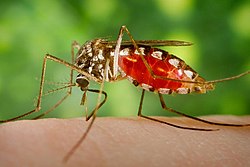| Armigeres subalbatus | |
|---|---|
 | |
| Scientific classification | |
| Kingdom: | Animalia |
| Phylum: | Arthropoda |
| Class: | Insecta |
| Order: | Diptera |
| Family: | Culicidae |
| Genus: | Armigeres |
| Species: | A. subalbatus |
| Binomial name | |
| Armigeres subalbatus (Coquillett, 1898) | |
| Synonyms | |
| |
Armigeres (Armigeres) subalbatus is a species complex of zoophilic mosquito belonging to the genus Armigeres . It is found in Sri Lanka, [1] India, Bangladesh, Myanmar, Pakistan, Nepal, Japan, China, Korea, Taiwan, Ryukyu-Retto, Indochina, Thailand, and Guam. [2]